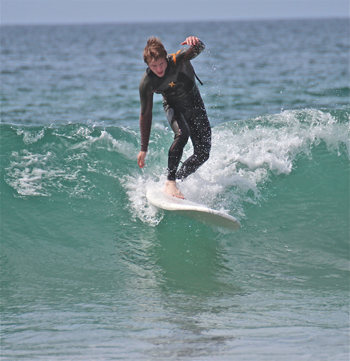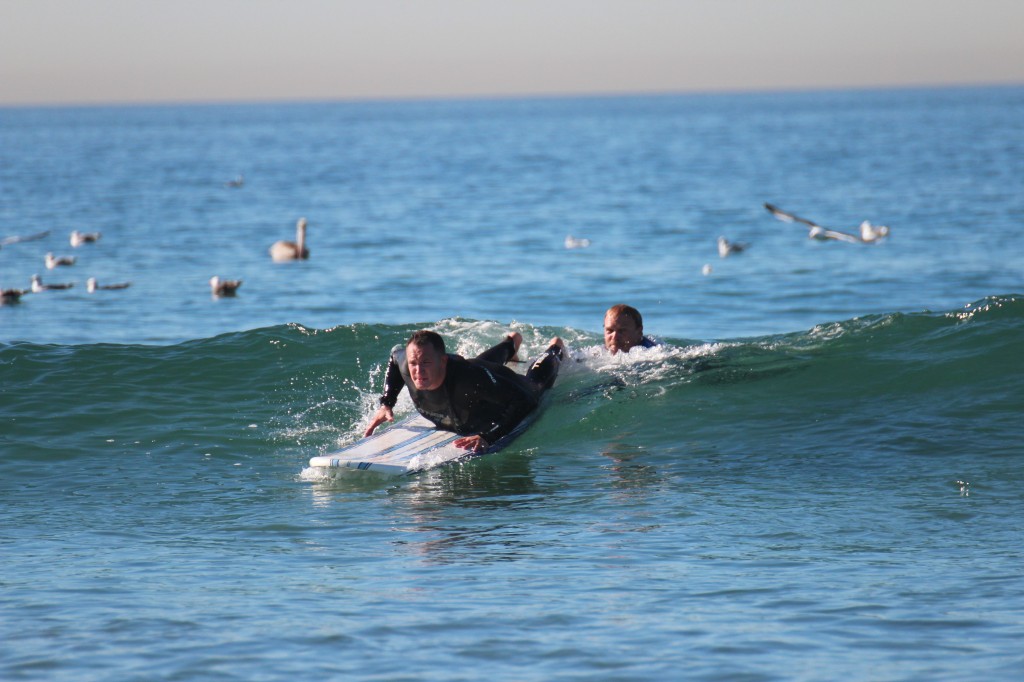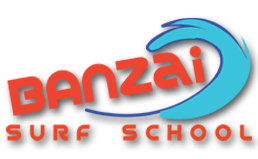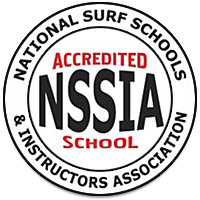 The takeoff will always be the hardest part of wave riding. Here, I’ll talk about the more advanced skill of catching an unbroken wave.
The takeoff will always be the hardest part of wave riding. Here, I’ll talk about the more advanced skill of catching an unbroken wave.
Let’s be honest; No respectable surfer wants to ride the whitewater. There’s just no speed there. Even dolphins won’t ride the soup, and they’re the best surfers on earth.
That said, we start 95% of our surf lessons in the whitewater because that’s the bunny hill, and that’s how you learn the basics. Sometimes I struggle with the ethics of that – that it’s a disservice to ‘real’ surfing – but we have to balance student talent against typical conditions. And 95% of beginners would get clobbered at the outside break.
One thing we’ve noticed with our students at Banzai Surf School; Once they DO get a taste of the open-face wave, there’s no going back. There’s no comparison to the feel of glide, that feel of flight that you get on the open wave. This is why surfers quit their jobs and leave home :).
But in order to get on the open face, you’ll need to find an easy wave, and you must master your takeoff. This may take years (With the right conditions, we’ve done it at Banzai in one lesson :).
A good takeoff requires several things:
• STRONG paddling skills
• Good wave judgment
• Agility; A good ‘popup’ (getting up to your feet quickly)
• Awareness
By now, you should have mastered basic skills: Be able to manage your board, find the paddling trim spot, get out thru whitewater, sit up and spin around, popup, etc. If you don’t have these skills, you shouldn’t be on the outside break near other surfers.

THE PERFECT TAKEOFF
Timing is key. You want to get onto the wave face BEFORE it goes past vertical. This is why it’s always better to learn on a big board: A big board paddles faster, and gets you into the wave easier with enough time to get up on your feet and ‘drop in’. (Read my blog ‘The Wrong Surfboard’ here)
When it comes to the takeoff, I always give these two pieces of advice: Paddle as hard as you can and watch the wave over your shoulder. If you see the wave behind you getting vertical, or worse yet pitching out, then you have to make a quick choice: You can sit up on the tail of the board and try to stall out of the wave, or bail off the side, OR, you can keep going and try your luck. Just jump up quick and keep weight on the tail!
“Pearl diving” or “pearling” is very common with beginners. This is a when the nose of your surfboard digs under the water. It also leads to spectacular rodeo-flip sinus-cleaning wipeouts. All you can do is get back on the horse and paddle back out.
Be aware though, that when you pearl and wipeout, your board usually shoots up in the air and is likely to come back down on your head; Whenever you wipeout, cover your noggin!
TRAINING
• Paddle! Get out there and work those rotator cuffs.
• Pop-ups; You can practice your pop-up on any carpet by laying down a straight line such as tape. Practice getting up and placing your feet directly over the line, standing wide and low!
• Wave judgment; When you’re with an instructor, you have the benefit of their many years of wave judgment. Otherwise, only water time will help. It doesn’t even have to be surfing; It can be bodysurfing or on a bodyboard with fins. The study of waves is science. For the surfer, it’s also a fascinating addiction.
There are days, especially here in Huntington Beach, when you’re just going to get frustrated. Sand bottom breaks are notoriously fickle; They build up, back off, shift over, jack up, and just generally tease you like crazy.
This comes with the sport. Good wave judgment takes years to learn. Even us ‘old pro’s’ get faked-out by Mother Natures’ curve balls. Some days it’s like fishing: You just settle for that one good one. I’ve carried memories of some of those good ones for twenty years. – Jaz Kaner
–pau-
(If you’re still struggling, maybe it’s the location. Read more about that here. )


What out-of-the-water exercises do you recommend to build up paddling strength and stamina?
Thanks!
Nelson, Great question. There’s no substitute for actual paddling, and if you’re surfing much, you’ll get LOTS of that; Surfing is 80% paddling. That’s the part you don’t see in those colorful surfing movies and videos :).
In place of that, any exercise that works the shoulder carriage; The lats, deltoids, infraspinatus, etc. You want to build up the RETURN stroke – work to prevent rotator cuff injuries. Using small weights, you stand upright doing a paddling motion, lifting the weights overhead. Also, lift and hold the weights with your arms outstretched at various angles.
I have read a few of your blog posts, and THIS is the one that solidified how I feel about coming out to Huntington Beach and getting lessons from the Banzai crew.
Looking forward to meeting you.